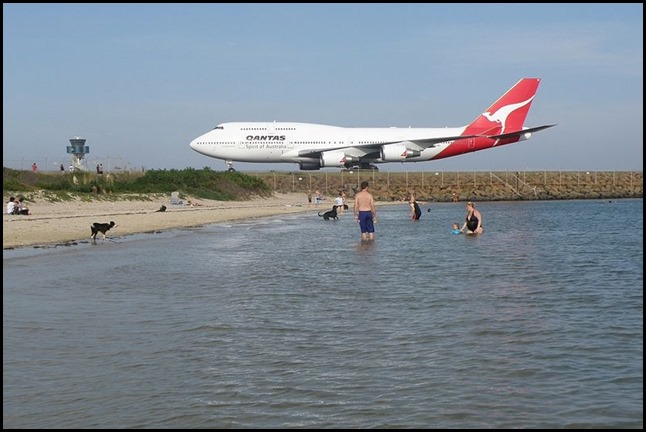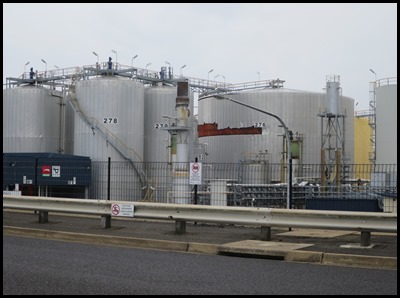Port Botany

|
Port Botany
Lieutenant James Cook first landed at Kurnell, on the
southern banks of Botany Bay, on Saturday the 29th of April 1770, when
navigating his way up the east coast of Australia on his ship,
HMS Endeavour.
Cook's landing marked the beginning of Britain's interest in Australia and in
the eventual colonisation of this new ‘southern continent’. Initially the name
Sting Ray Harbour was used by Cook and other journal keepers on his expedition,
for the stingrays they caught. That name was also recorded on an Admiralty
chart. Cook's log for the 6th of May 1770 records "The great quantity of these
sort of fish found in this place occasioned my giving it the name of Stingrays
Harbour". However, in the journal prepared later from his log, Cook wrote
instead: (sic) "The great quantity of plants Mr. Banks and Dr. Solander found in
this place occasioned my giving it the name of Eighteen years later, in 1788, Governor Arthur Phillip sailed the armed tender HMS Supply into the bay on the 18th of January. Two days later the remaining ships of the First Fleet arrived to found the planned penal colony. However, the land was quickly ruled unsuitable for settlement as there was insufficient fresh water; Phillip also believed the swampy foreshores would render any colony unhealthy. Phillip decided instead to move to the excellent natural harbour of Port Jackson to the north. On the morning of the 24th of January the French exploratory expedition of Jean-François de Galaup, comte de Lapérouse was seen outside Botany Bay. On the 26th of January, the Supply left the bay to move up to Port Jackson and anchor in Sydney Cove. On the afternoon of the 26th January, the remaining ships of First Fleet arrived at Sydney Cove. In 1789, Captain John Hunter surveyed Botany Bay after returning from the Cape of Good Hope, trading for grain. The good supply of fresh water in the area led to the expansion of its population in the 19th century.
After watching the Sydney Hobart Yacht Race set off, we drove toward Botany Bay, leaving at Liverpool...........toward the M5.
We were parallel to Botany Port by Bay B199.
We sat and ate our picnic, in the rain, looking out of the entrance to Botany Bay. To the right we saw a single flash of lightning, the predicted southerly buster was coming somewhat earlier.
A yacht race straggler passed.
The beach to our left soon emptied as the rain fell.
How to tame a badly behaved umbrella.
Botany Bay, we sat half way along the point above the ship. The runways of Sydney Airport built out on reclaimed land.
A wonderful Wiki picture of a new arrival.
The First Fleet is the name given to the eleven ships that left Great Britain on the 13th of May 1787 to found the penal colony that became the first European settlement in Australia. The fleet consisted of two Royal Navy vessels, three store ships and six convict transports, carrying more than a thousand convicts, marines and seamen, and a vast quantity of stores. From England, the Fleet sailed southwest to Rio de Janeiro, then east to Cape Town and via the Great Southern Ocean to Botany Bay, arriving in mid-January 1788, taking two hundred and fifty to two hundred and fifty two days from departure to final arrival in all kinds of sea conditions including terrible storms. · The 13th of May 1787 – The eleven ships of the First Fleet leave Portsmouth under the command of Captain Arthur Phillip. Different accounts give varying numbers of passengers but the fleet consisted of at least 1,350 persons of whom 780 were convicts and 570 were free men, women and children and the number included four companies of marines. About 20% of the convicts were women and the oldest convict was 82. About 50% of the convicts had been tried in Middlesex and most of the rest were tried in the county assizes of Devon, Kent and Sussex · The 18th of January 1788 – The First Fleet arrived in Botany Bay but the landing party was not impressed with the site, and moved the fleet to Port Jackson, landing in Sydney Cove on the 26th of January 1788 (now celebrated as Australia Day) The majority of the people on the First Fleet were British, but there were also African, American and French convicts on board. The group included seamen, marines and their families, government officials, and a large number of convicts, including women and children. The convicts had committed a variety of crimes, including theft, perjury, fraud, assault and robbery. The sentences the convicts received were transportation for seven years, fourteen years or for the term of their natural life. The six convict transports each had a detachment of marines on board. Most of the families of the marines travelled aboard the Prince of Wales. A number of people on the First Fleet kept diaries and journals of their experiences, including the surgeons. There are twelve known journals in existence as well as some letters. The exact number of people directly associated with the First Fleet will likely never be established, as all accounts of the event vary slightly. A total of 1,420 people have been identified as embarking on the First Fleet in 1787, and 1,373 are believed to have landed at Sydney Cove in January 1788.
First Fleet Memorial.
When the Bellona transport came to anchor in Sydney Cove on the 16th of January 1793, she brought with her the first immigrant free settlers. They were: Thomas Rose, a farmer from Dorset, his wife and four children; he was allowed a grant of 120 acres; Frederic Meredith, who had formerly been at Sydney with HMS Sirius; Thomas Webb (who had also been formerly at Sydney with the Sirius), his wife, and his nephew, Joseph Webb; Edward Powell, who had formerly been at Sydney with the Juliana, transport, and who married a free woman after his arrival. Thomas Webb and Edward Powell each received a grant of 80 acres; and Joseph Webb and Frederic Meredith received 60 acres each. The conditions they had come out under were that they should be provided with a free passage, be furnished with agricultural tools and implements by the Government, have two years' provisions, and have grants of land free of expense. They were likewise to have the labour of a certain number of convicts, who were also to be provided with two years' rations and one year's clothing from the public stores. The land assigned to them was some miles to the westward of Sydney, at a place named by the settlers, "Liberty Plains". It is now the area covered mainly by the suburbs of Strathfield and Homebush.
After our picnic looking out over Botany Bay we drove Prince of Wales Road at the end of the Port – open from sunrise to sunset with a helpful telephone number if you get locked in.
Port Botany is a deepwater seaport located in Botany Bay, in Sydney, Australia with 270 berths. The port is dominated by trade in containerised manufactured products, and to a lesser extent, bulk liquid imports including petroleum and natural gas. Port Botany is Australia’s second busiest container port, servicing the largest population base in Australia and is administered by NSW Ports which entered into a 99-year lease agreement with the NSW Government in May 2013. Port History: Prior to 1960 Sydney's international shipping facilities were exclusively located in Port Jackson, with bulk and break bulk docks at Darling Harbour and Walsh Bay and bulk and ro-ro docks at Glebe Island and White Bay.
A plane coming in to land.
The end of the road for us at Gate B21.
Colour me happy.
With the advent of containerisation in the late 1950’s it became clear that Sydney would require additional port facilities to cater for new cargo types. In the 1960’s the government agency responsible for ports, the NSW Maritime Services Board, recommended that a new port complex be developed in the northern part of Botany Bay adjacent to Sydney Airport. The New South Wales Government endorsed the proposal in 1969 and in 1971 work commenced on two container terminals to the north, and a bulk liquid wharf and storage area to the south. In 2011 the port saw the arrival of 1,578 vessels.
Just a thirty seven minute turnaround time for trucks.
November 2015 Report: Total container volume was 4.6% up on the same period last year, due to an increase in full containers for both imports and exports, full container exports were up over 10% with import full up over 7%. The month of November had 93 container vessel visits which is the same as last year, however in the 5,000 to 6,000 TEU capacity vessels there was an increase of 3% providing for greater exchanges. Non containerised cargo total volume was down 1.2% compared to the previous November or 5,000 RT, this drop was mainly attributed to refined fuels being down by 2% compared with last year, gas was up marginally.
A couple of the bulk containers didn’t look so very well.
Just wow.
ALL IN ALL A REAL TREAT BIG, IF NOT HUGE |


























